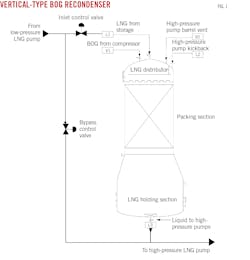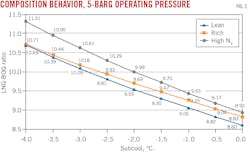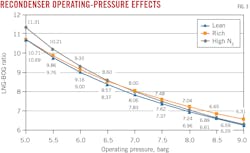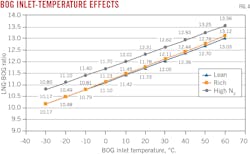LNG-BOG ratio management depends on recondenser dynamics
Jin-Wen Chang
CTCI Corp.
Taipei, Taiwan
Dattaray Kolte
Muscat, Oman
Subcool and recondenser operating pressure have a large impact on LNG/boil-off gas (BOG) ratios for different natural gas compositions when set against BOG inlet temperature. In fact, for recondensers, the degree of subcool and the LNG-BOG ratio are interdependent.
Background
LNG recondensers are one of the key components of an LNG terminal, using contact with cold LNG to recover BOG generated from various sources. LNG recondensers are typically sized to deal with BOG generated in all applicable operating scenarios. The amount of BOG generated in LNG terminals can vary based on location, other environmental effects, and operating conditions.
LNG terminals discussed in this article are in southern India, eastern India, southern Thailand, and Taiwan and have send out capacities of 5-10 million tonnes/year (tpy). BOG generation ranged from 2 to 50 tonnes/hr (tph). For each operating case, the suitability and capability of the LNG recondenser should be confirmed in advance to ensure stable operation. This article will focus on operating cases of LNG recondensers in regards to their impact on the scale of other systems.
The packing section of a recondenser is where recondensation occurs. In India, Thailand, and Taiwan, packing sections typically have IDs of 2.5-3 m and are 3-3.5 m tall (Fig. 1). They are designed to recover 40-50 tph of BOG via a -4° C. degree subcool at the outlet.
Operating, design cases
BOG recondensers should be able to operate effectively in all scenarios. Gauging the degree to which this happens requires 30-40 operating cases. This article considers maximum-minimum BOG-generation cases and maximum-minimum LNG send-out cases across lean, rich, and high N2 compositions.
Tables 1-2 summarize the various possible operating cases for LNG recondensers. The LNG temperature at the recondenser outlet is kept in a saturated condition at 0° C., using a -4° C. subcool.
BOG recondenser sensitivity
In an LNG recondenser, the LNG-BOG ratio should be maintained to ensure 100% condensation of BOG. When sizing the recondenser, LNG subcool of -4 to 0° C. at the recondenser outlet needs to be attained.
Parameters which impact recondenser performance are:
- LNG inlet flow.
- BOG inlet flow.
- BOG inlet temperature.
- LNG inlet temperature.
- LNG/BOG ratio.
- Recondenser operating pressure.
- Design degree of subcool.
To determine the sensitivity of recondenser performance, only one parameter at a time is studied as the variable potentially affecting LNG-BOG ratio. All other parameters are kept constant unless they are interdependent. For example, when the BOG flow is kept constant, the LNG flow needs to be varied to reach the required degree of subcool at the recondenser outlet. Meanwhile, other parameters such as the degree of subcool, recondenser operating pressure, and LNG and BOG inlet temperatures are kept constant.
- Case 1: Degree of Subcool. LNG temperature at the recondenser outlet is always saturated at the operating pressure of the recondenser without margin in a normal situation. However, some degree of subcool (-4° to 0° C.) can be taken for margin during design. Conservatively, -4° C. is specified for sizing purpose as engineering practice. This section studies the impact of the degree of subcool at the recondenser outlet on the LNG-BOG ratio for various LNG compositions (Tables 1-2).
N2 in the stream is the non-condensable component which can only dissolve into LNG depending on solubility in relation to temperature, since operating pressure is kept constant. Therefore, high-N2 composition requires more LNG to subcool the outlet stream from the recondenser.
- Case 2: Recondenser operating pressure. LNG recondenser operating pressure depends on the efficiency of BOG recovery. The pressure normally adopted is 5-10 barg.1 However, lower side pressure is preferable considering a 150-lb rating, piping under temperature, and pressure limit. Any increase in the recondenser pressure delivers less LNG to the recondenser.
Constant parameters are BOG flow (~25,000 kg/hr), BOG temperature (-13° C.), and degree of subcool (-4 °C.). The variable parameter is recondenser operating pressure (5-9 barg).
An increase in recondenser operating pressure results in a lower LNG requirement and vice versa (Fig. 3). Recondenser operating pressure has a large impact on the required LNG-BOG flow ratio. In fact, any sudden change in LNG inlet valve opening will change LNG flow to the recondenser, immediately impacting recondenser operating pressure. This will be difficult to control and will possibly trigger instability and further impact the BOG compressor upstream and high-pressure pump downstream of the recondenser. Hence for operational stability, the operator should always try to maintain stable LNG recondenser pressure.
- Case 3: BOG inlet temperature. Normally, the inlet temperature of BOG to the recondenser varies widely, ranging from -40° C. to 65° C. in the BOG compressor discharge. Since the slopes of the curves for lean, rich, and high N2 gas compositions are nearly identical, regardless of actual temperatures, the impact from the change in BOG inlet temperature will mostly be the same.
The inlet temperature of BOG to the recondenser is mainly determined by the ambient heat input, BOG compressor efficiency, and BOG flow rate, and affects the required LNG flow to the BOG recondenser. Generally, the higher the inlet temperature, the higher the LNG requirement for recondensation. This section studies the impact of BOG inlet temperature on the LNG-BOG ratio for various LNG compositions, as shown in Tables 1-2.
Constant parameters are BOG flow (~25,000 kg/hr), degree of subcool (-4° C.), and recondenser operating pressure (5 barg). The variable parameter is BOG temperature (-30 to 60° C.)
Fig. 4 also shows that the effects from BOG inlet temperatures on the LNG-natural gas ratios for lean and rich cases are almost identical. BOG streams with either lean or rich compositions have close enthalpy due to the small deviations in composition. There was a little more impact on the high-N2 case than the other two cases.
Control-valve sizing
LNG at the outlet of the BOG recondenser is always at saturated condition. When preparing the heat and material balance (HMB), -4° C. of subcool is used to be conservative. In the actual case, however, since LNG at the outlet of recondenser’s packing section is always at saturation, the required LNG flow or LNG-BOG ratio will be lower than the required value calculated for HMB. This will result in higher LNG flow via the recondenser bypass stream.
When sizing the control valve at the BOG recondenser inlet and bypass, engineers should always keep in mind the oversizing consideration in the HMB, especially when selecting the maximum and minimum cases for control valves. This factor will be more significant in minimum cases.
Generally, the minimum case for recondenser bypass control valve occurs at the minimum rate of natural gas send out. For the minimum natural gas send out case, the BOG flow will be higher, as will the required LNG flow to the recondenser. This will result in lower availability of LNG via the recondenser bypass. Hence, this case will decide the minimum flow for the bypass control valve. If the designer follows HMB, the flow available at the recondenser bypass will be lower, as higher LNG flow is diverted to the recondenser inlet because -4° C. of subcool is considered in the design.
This will eventually result in lower flow for the minimum case and widening the maximum and minimum flow range for the bypass control valve. A similar scenario is also applicable regarding the recondenser inlet control valve. To avoid too wide a span for achieving optimum control valve sizing, process engineers should keep in mind the oversizing factor in design and relax it wherever required as per engineering judgement while sizing other systems.
Ideally the high-N2 case should be avoided due to its requirement for more LNG (i.e. more energy consumption).
The authors
Jin-Wen Chang ([email protected]) is a process expert within the process department of CTCI Corp, Tapei, Taiwan. He has 36 years of experience in the refinery, petrochemical, and chemical industries. Chang earned a PhD in chemical engineering from the National Taiwan University of Science and Technology. He is also a registered engineer in Taiwan.
Dattaray Kolte is a senior process engineer based in Muscat, Oman, with more than 16 years of experience in the LNG, refinery, and petrochemical industries. Kolte earned a bachelor of technology degree in chemical engineering from UDCT –Jalgaon KBC North Maharashtra University, India.
Reference
- Lemmers, S.P.B., “Simplify BOG recondenser design and operation—Part 1,” Gas Processing & LNG, June 1, 2024.





